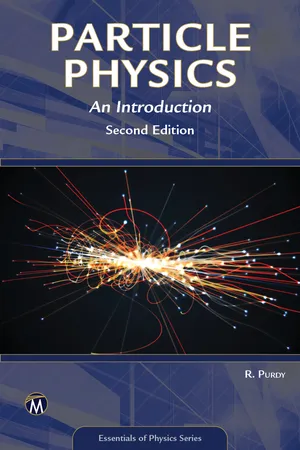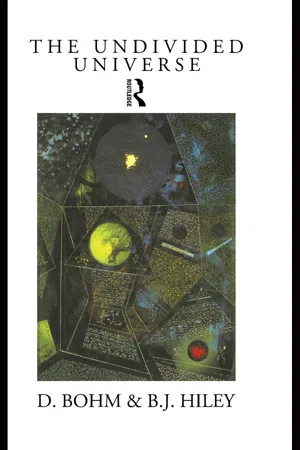Physics
Pauli Matrices
The Pauli matrices are a set of three 2x2 complex matrices named after physicist Wolfgang Pauli. They are widely used in quantum mechanics and quantum information theory to represent spin operators for spin-1/2 particles. The Pauli matrices are fundamental in describing the behavior of particles with intrinsic angular momentum, and they play a crucial role in the theory of quantum mechanics.
Written by Perlego with AI-assistance
Related key terms
Related key terms
1 of 4
Related key terms
1 of 3
3 Key excerpts on "Pauli Matrices"
- eBook - ePub
Particle Physics
An Introduction
- Robert Purdy(Author)
- 2022(Publication Date)
- Mercury Learning and Information(Publisher)
s is a fundamental property of elementary particles. In fact, due to the spin-statistics theorem and the Pauli exclusion principle, it is the quantum number that determines the behavior of the particle arguably more than any other.3.5. SPIN PARTICLES AND THE Pauli MatricesThe particles of the standard model all have spin quantum numbers of 0, , or 1, and of these, the only fermions are the spin particles. Since fermions make up what we typically think of as matter, it is important to have a good understanding of the quantum mechanical behavior of spin- particles. In particular, in many physical systems, it is electrons that underpin the mechanics of the system, so we must be able to model the behavior of electrically charged spin- particles. We will see in Section 3.8 how to include electromagnetic interactions, but for now, let us find a way to model the spin of an electron.Since spin is an angular momentum, the spin operators must obey the correct angular momentum commutation relations (Equation 3.25). In addition, each operator must have only two eigenstates with eigenvalues of . In the language of Section 4.3.1 , we wish to find a two-dimensional representation of the algebra defined by Equation 3.25. This is achieved by the matrices , where σ i are the Pauli Matrices:(3.36)Notice that σ 3 is chosen to be diagonal since it is conventionally the z- axis along which the spin is measured. The reader is invited to check that the above matrices ∑ i do indeed satisfy Equation 3.25. Furthermore, the eigenvalues for each operator are easily shown to be as required.Since we are representing the spin operators with 2 × 2-matrices, we must similarly use a two-component column matrix for the state vector. Since this state vector is introduced specifically to describe spin, it is known as a spinor . This is a term whose meaning has expanded greatly since its original introduction, and we will be seeing much more of the concept in Chapter 8 . In this representation, we can show that the eigenstates of ∑ 3 are given by (with eigenvalue ), and (with eigenvalue − - Konstantin V. Kazakov(Author)
- 2012(Publication Date)
- Elsevier(Publisher)
m is its mass. We begin from Schrödinger’s equation,for states φ; t denotes time. For operator H , we choose the classical expression for a Hamiltonian describing the electron in an external field with vector potential A and scalar potential U , i.e.Adding to this expression the energy of interaction between the electron magnetic moment and the magnetic field, which is characterized by vector B ,we obtain Thus,Pauli obtained this equation, which describes a motion of the electron in an external electromagnetic field. Pauli’s equation is readily generalized for the case of another elementary particle that possesses non-zero spin.We consider in detail the case s =1/2. With s , it is here convenient to introduce a new quantity, σ (σ x , σ y , σ z ):for σ , we have σ ×σ =2iσ . As s z has eigenvalues ± /2, component σ z possesses values ±1 and has only one value, +1. Thus,Using this equality, we find Also,but [σ y , σ z ]=2iσ x , such thatHence, σ x and σ y commute with an opposite sign, i.e. they anticommute. The same conclusions occur for other variables:To determine an explicit form σ , we recall the formulae obtained earlier for the non-zero matrix elements of raising operator L + and lowering operator L − of angular momentum L (L x , L y , L z ):Here, is a quantum number that characterizes squared angular momentum L 2 and k correspondingly for projection L z . As L x =(L + +L − )/2 and L y =(L + −L − )/2i, thenandin which 〈 ,k +1|L − |andk〉=0. In an analogous manner,We apply these formulae to spin one half. Assume that L = σ /2, =s , and let quantity k retain the preceding meaning of the quantum number of the z -component of angular momentum. We haveand moreover,s =1/2, whereas k =±1/2; one might consequently represent the components of quantity σ in a form of 2×2 Pauli Matrices,The spin variables separately commute with coordinates x , y and z- eBook - ePub
The Undivided Universe
An Ontological Interpretation of Quantum Theory
- David Bohm, Basil J. Hiley(Authors)
- 2006(Publication Date)
- Routledge(Publisher)
figure 10.4 .10.3 The many-body Pauli equation
As shown in BST [1 , 2 ], the model described here works consistently and provides an adequate ontological interpretation of the Pauli equation for a one-body system. However, this model gets into very serious difficulties when we try to extend it to a many-body system. To show what these difficulties are, let us begin by considering the general wave function for such a system, This has 2N complex components (or 2N+1 real components).Figure 10.1: Trajectories during spin measurement withFigure 10.2: Field of orientations θ(z, t) associated with figure 10.1Figure 10.3: The trajectories for a Gaussian distribution of initial positions in the region of wave packet separation during a spin measurement with andFigure 10.4: The field of orientations θ(z, t) associated with figure 10.3The many-body Pauli equation is then (assuming B=0)(10.16)From this we obtain the net probability density in the configuration space of all the particles(10.17)(See section 10.4 for a more detailed discussion of the many-body wave function.) Let us then define the current density in configuration space as(10.18)It then follows from the Pauli equation that(10.19)The above expresses the conservation of probability in configuration space. In analogy with what was done in the many-body Schrödinger equation, this suggests that we define the particle velocity as(10.20)The above can be regarded as a generalisation of the guidance condition, while the conservation equation (10.19 ) implies that particles guided in this way will have a conserved probability density. But to complete the interpretation, we need to define the spin-vectors. In agreement with what was done with the velocities, the spin of the nth particle, Sn ,
Index pages curate the most relevant extracts from our library of academic textbooks. They’ve been created using an in-house natural language model (NLM), each adding context and meaning to key research topics.
Explore more topic indexes
Explore more topic indexes
1 of 6
Explore more topic indexes
1 of 4


